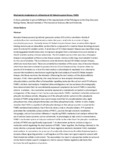Please use this identifier to cite or link to this item:
https://cris.library.msu.ac.zw//handle/11408/1686| Title: | Mechanistic modulation of a bifunctional GC-linked receptor kinase, PSKR1 | Authors: | Muleya, Victor | Keywords: | Phytosulfokine receptor (PSKR1), Guanylate cyclase activity, Kinase activity, Phosphorylation, Signaling, Calcium, Dimerisation | Issue Date: | 2015 | Publisher: | Monash University | Abstract: | Receptor kinases possessing intrinsic guanylate cyclase (GC) activity constitute a family of catalytically active membrane-bound proteins that play crucial roles in a myriad of signal transduction processes. Currently known GC-linked receptor kinases have an extracellular ligand-binding domain and an intracellular portion that is composed of an inactive kinase homology domain and a functional GC catalytic centre. A novel class of GC-linked receptor kinases was unearthed using homologyguided bioinformatic data mining tools designed from annotated amino acid residues in the GC catalytic centres of lower eukaryotes. The GC catalytic centre in this new class of receptor kinases is encapsulated within an active kinase domain, thereby conferring a dual catalytic function to this class of proteins. This is contrary to currently known classical GC-linked receptor kinases, which are mono-functional. There are currently four members of this novel class of receptor kinases which have been demonstrated to possess intrinsic GC and kinase activity. However, there is a paucity of information as to how this dual catalysis is physiologically regulated. In an attempt to uncover the modulatory mechanisms regulating the dual catalysis of novel GC-linked receptor kinases, this thesis examines the elements influencing the dual catalysis of the phytosulfokine receptor, PSKR1. Most specifically, this study focuses on how receptor dimerisation, phosphorylation, and the effect of intracellular signalling molecules like calcium and ATP influence PSKR1’s intrinsic dual catalysis. Analytical ultracentrifugation and size exclusion chromatography have demonstrated that the recombinantly expressed cytoplasmic domain of PSKR1 is reversibly dimeric in solution. This observation probably represents a catalytically competent iv physiological arrangement of the receptor that may be a pre-requisite for PSKR1- mediated nucleotide cyclase and phospho-transferase activity. Mapping out of the phosphorylation pattern in the cytoplasmic domain of PSKR1 using tandem mass spectroscopy identified 14 phosphorylation sites; eight phosphoserines, three phosphothreonines and three phosphotyrosines. Further in vitro studies revealed that PSKR1 is capable of self-phosphorylating and that phosphorylation is essential for PSKR1-mediated dual catalysis. Apart from its obvious role in phosphorylation, ATP seemed to potentiate the nucleotide cyclase activity of PSKR1, possibly through allosteric modulation. Intriguingly, calcium had a direct influence in regulating PSKR1-mediated dual catalysis without the aid of calcium sensor proteins such as calmodulin. At physiologically high calcium concentrations, PSKR1’s nucleotide cyclase activity was enhanced while on the other hand the phospho-transferase activity of PSKR1 was significantly suppressed. This observation points to calcium acting as a molecular switch regulating the dual catalysis of PSKR1. Taken together, the findings obtained in this study informs a proposed model of how all these regulatory elements modulate PSKR1-mediated dual catalysis. In summation, the presence of catalytically relevant motifs within functional protein domains allows signalling proteins to self-regulate and fine-tune their signal output in concert with their immediate cellular environment. This necessitates the need for prospective studies to carry out similar bioinformatics search strategies in order to uncover hidden regulatory elements that facilitate the self-regulation of proteins. | URI: | http://arrow.monash.edu.au/vital/access/manager/Repository/monash:155899 http://hdl.handle.net/11408/1686 |
| Appears in Collections: | Thesis |
Files in This Item:
| File | Description | Size | Format | |
|---|---|---|---|---|
| Dr Muleya thesis.pdf | 210.38 kB | Adobe PDF |  View/Open |
Page view(s)
154
checked on Nov 23, 2025
Download(s)
78
checked on Nov 23, 2025
Google ScholarTM
Check
Items in MSUIR are protected by copyright, with all rights reserved, unless otherwise indicated.



